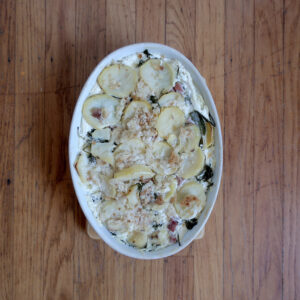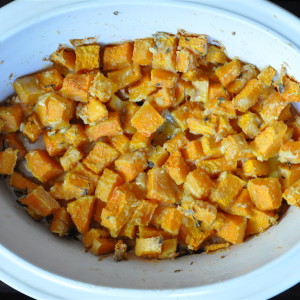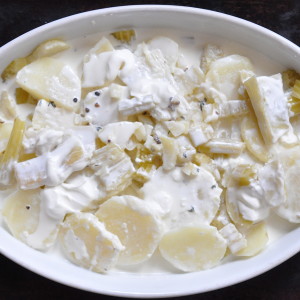Spinach and Potato Tian
Elizabeth David, writing in Is There A Nutmeg In The House, describes a tian as “an open earthenware casserole or gratin dish called in the Provencal language a tian….”
David goes on to say there is no fixed recipe for a tian beyond using “a certain proportion of freshly cooked green vegetable–spinach, spinach beet, or chard (the kind the French call blettes) bulking them out…with potatoes or rice…and mixing them up with eggs beaten as for an omelette.” (53)

Optional additions to a tian may include garlic, anchovies, capers, or any of the allium tribe, along with grated cheese and fresh herbs. Some cooks include a fresh tomato sauce. Others omit the eggs but add breadcrumbs. Mrs. David gives five tian recipes in Nutmeg. Three use zucchini. The fourth is the spinach and potato recipe posted here.

—
In The Pedant In The Kitchen, Julian Barnes hiliariously details his experiences as “A Late-Onset Cook.” Being both a late onset cook and a writer, Barnes demands precision in recipes. More often than not, Barnes is disappointed.
How big is a ‘lump’, how voluminous is a ‘slug” or a ‘gout’, when does a ‘drizzle’ become rain? Is a ‘cup’ a rough-and-ready generic term or a precise American measure?
The Pedant In The Kitchen, 19
I cite Barnes because David’s tian recipe, a seemingly simple dish, soon had me flummoxed. Should I butter or oil the pan? Why did she parcook the spinach? What did she mean by “cook as before”? (She was referring to another tian recipe on the facing page.)
Recipe writing has changed over time. Leaf through any cookbook published during the 1960’s and you’re certain to find the following sentence: “Make the pastry in the usual way.” Such writing is unimaginable today: readers expect, even demand, culinary processes be detailed down to the last crumb. Mrs. David’s measurements in wineglasses and after-dinner coffee cups would spur outrage (along with countless emails and social media posts asking for clarification).

Neither after-dinner coffee cups nor wineglasses. Pretend.
Whether or not detailed recipes/cooking processes are a good or bad trend are questions for another day. For now, know that my confusion sent me to Richard Olney’s Simple French Cooking. There I was set straight on several points concerning the tian and how to best prepare it.

Olney rubbed his tian (a gratin dish) with olive oil. He did not parcook the greens. Instead, he tossed everything into a big bowl. There, he instructed readers to
mix intimately with your hands, squishing the mixture repeatedly between your fingers
Simple French Food (236)
I gratefully followed suit.

—
If you leave this post with nothing else, know that tian means both the physical dish itself and the food prepared inside it. That food ranges from fresh greens to eggs to tomatoes to potatoes.

The potatoes must be parcooked, or your tian will be unpleasantly lumpen. Pierce the potatoes once or twice to avoid messy explosions, then boil, steam, or microwave them in their skins. When the potatoes are cool enough to handle, peel and cube them. If you microwave the potatoes first, they can cool while you prep the remaining tian ingredients.

If you opt to include anchovies, take care when salting the tian.

Garlic is also optional.

Both Olney and David add Parmesan cheese in their tians. Following their example, I grated about three tablespoons into the vegetable mixture and more over the top.

Three large eggs made a compact tian verging on dryness. Five large eggs gave a moister result. The tian was still dense–that’s the nature of the dish–but pleasantly so.

Oil your baking pan lavishly. If you don’t, the tian won’t slice neatly. Trust me.

Like their close relative the frittata, tians hold well refrigerated and taste good at any temperature. Mrs. David describes the tian as the favored picnic dish of families living in Arles, Avignon, and Aix-en-Provence. I am not a fan of picnicking, but can report the tian is delicious at any hour. Leftovers, if you are lucky enough to have any, make fabulous sandwiches, with or without mayonnaise.
Spinach and Potato Tian
recipe created with help from Elizabeth David’s Is There A Nutmeg in The House? and
Richard Olney’s Simple French Food.
Serves 2-3 for breakfast, lunch, or dinner
Prep time: potatoes need to be parboiled, steamed, or microwaved, which takes 4-10 minutes, depending on cooking method. Light prep and tian assembly takes 15-20 minutes for a slower cook (like me). The tian takes 45-50 minutes to bake.
You will need a large bowl, a small bowl, and a ceramic or clay shallow-sided baking dish or gratin . I used a ceramic gratin dish measuring 12 inches/30cm by 9in/23cm.
250-300 grams/8-10 ounces waxy potatoes
454 grams/16 ounces spinach
2-3 tablespoons grated Parmesan cheese, plus more for the top
2-4 salted anchovies (optional)
approximately 2 tablespoons parsley (optional)
1-2 garlic cloves (optional)
4-5 large eggs
olive oil, for the dish and for drizzling over the top of the tian
salt and pepper
Preheat the oven to 350F/180C. Lavishly oil a gratin dish, earthenware baking dish, or other suitable baking dish with olive oil. I did this by pouring olive oil into the dish and smearing it around with a piece of paper towel.
Parcook the potatoes by piercing each first in a couple places, then boiling, steaming, or microwaving them. They should be almost cooked through. I microwaved mine for four minutes.
While the potatoes cool, rinse spinach, if necessary, and pat dry. Roughly chop and add to large bowl. I did this in batches.
Grate Parmesan cheese directly into the bowl, atop the spinach.
Rinse anchovies, if using, under running tap. You don’t have to blast the water: just run it gently. Tear fish into strips. This should be easy to do. Add fish to bowl.
Roughly chop parsley, if using, and add to bowl.
Crush garlic, if using, and mince it, and-you guessed it–add it to the bowl.
Check the potatoes. If they are cool enough to handle, peel them. The peel should be easy to remove-I did not need a vegetable peeler. Cube potatoes and add to bowl. Don’t worry if potatoes crumble. Just do the best you can.
Crack eggs in the small bowl. Beat them just to blend the yolks. Pour into the big bowl. If you used anchovies, salt lightly–you can always add salt later. But you can’t fix oversalting. Now add about a teaspoon pepper.
Wash your hands. Now plunge them into the bowl and mix tian ingredients together. At first it may seem like the mixture won’t fit in your baking dish. Don’t worry. It will start packing down and fit into the dish.
You can use a large spoon for this step, but nobody is looking. Take handfuls of the tian mixture and place them in the baking dish. It’s the easiest way, and saves washing up.
Once all the spinach/egg/potato mixture is in the baking dish, pat it down gently. Wash your hands. Now add a little more olive oil to the top, zigzagging across the entire surface of the tian.
Add some more cheese, if desired.
Place tian in oven and bake, 45 minutes to i hour.
Tian is ready when the edges are just browning and the top just dry. It should spring back lightly when touched, like a cake. Do not overcook–you don’t want the middle of the tian browning or drying out.
Serve tian with good bread and a salad.
Covered and refrigerated, tian will hold for 5 days or so. Freezing not recommended.
Notes
I used prewashed, organic baby spinach. The stems were soft enough to use. Other greens to try: stemmed, chopped chard, mustard greens, watercress, or beet greens.
Feel free to use other fresh herbs like mint, oregano, or basil.
Gruyere or Cheshire cheese are good alternatives.
Interested readers are encouraged to consult the following four books for additional tian recipes and overall culinary excellence.
Elizabeth David Is There A Nutmeg In The House?
Madeleine Kamman When French Women Cook
Richard Olney: Simple French Food
Paula Wolfert Clay Pot Cooking
Broadly speaking, tians may be made from greens, and may include eggs. From there, it is a question of what vegetables are in season and what you have to hand. Trying to quantify what goes into a tian is a bit nervewracking. It’s easier, perhaps to tell you what not to put in it. Avoid add potato chips. Or snack cakes. Canned veg is out. So is aquafaba, a product I do not understand anyway. Then again, the older I get, the less I understand. I believe this is called wisdom.
None of the above should be taken as criticism of Elizabeth David. I happened on the tian recipe while rereading Is There a Nutmeg in the House?, marveling, as I always do, at Mrs. David’s incredible depth of learning and exquisite prose. I am not fit to wash her floors.





